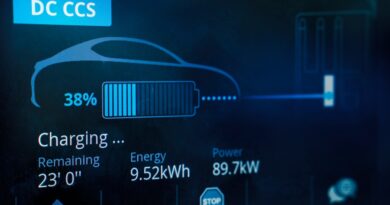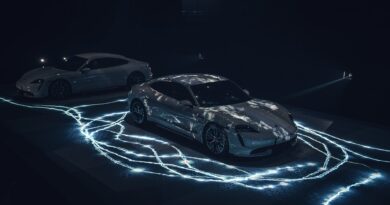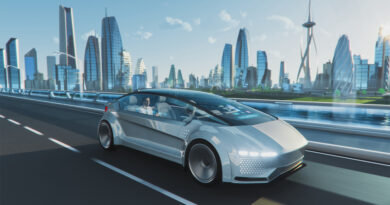What will we see this year? EV Powered’s predictions for 2023
As we turn the corner into 2023, major players from within the EV industry share their thoughts on what this year might have to offer!
Why solar-compatible EV chargers are the tech to watch in 2023
Jordan Brompton, myenergi
“While solar is one of the most cost-effective iways to generate decentralised power, its Achilles heel remains. After all, most household energy is used in the evenings, but solar energy is generated during the day. Unless you have a comprehensive storage solution, like our all-new libbi smart battery, it’s most likely that you’ll export sustainable power at periods of low consumption and buy back mains supply at a more expensive rate when you need it.
“With the transition to electrification continuing at pace and the rate of solar installs rocketing, we believe that everyone who either has solar PV – or has the opportunity to install it in the future – should consider investing in a solar-compatible charger. They’re the perfect, future-proof solution to maximise self-consumption.
“The cost of grid generation is well outside the control of homeowners, which makes it the perfect time to become more independent. With concerns about ongoing price hikes, self-generation, energy independence and smart eco-smart technologies can provide the solution.”
High-efficiency inverters lead the ‘third wave’ of electrification
Steve Lambert, Head of Electrification, McLaren Applied [Small headshot of Steve]
“We believe that high-efficiency inverters that offer higher switching frequencies and unparalleled controllability will play an important part in the transition to electrification, because they add character to vehicles thanks to improvements in packaging and performance.
“We see silicon carbide (SiC) as leading the ‘third wave’ of electrification. The first wave involved early pioneers of technology, and we’re currently in the second wave where EVs have broken through to the mainstream. The third stage is efficiency and will see inverter technology rapidly adopt SiC semiconductors, especially in 800V architectures and vehicles that need longer range where efficient power electronics are key.
“Efficiency is going to be the battleground. It’s how brands will compete with one another. If you’re more efficient, you can have a better vehicle. It’s going to be lighter. It’s going to get a better range from the energy you have. It will be quicker to recharge because you need less energy for a given distance. When it comes to efficiency, silicon carbide excels, and will be the defining feature of the third wave.”
A need to improve customer and driver experience
Philip Nothard, Insight and Strategy Director, Cox Automotive
“We are observing the transition towards an EV-dominated new vehicle market share in the UK, European markets, and globally; however, there remain obstacles to overcome. The rising raw material costs are bumping up retail prices, impacting and dissuading consumers from purchasing the sustainable vehicle alternative. Alongside the energy crises we currently find ourselves in, reports are emerging that the TCO (Total Cost of Ownership), compared to their equivalent combustion counterpart, is under question. Unprecedentedly rising raw material costs have underpinned the ever-soaring battery prices, and even whether there will be a sufficient supply of raw materials to satisfy the demand remains to be seen.
“With the recent Autumn Statement announcement, scrapping the tax exemption on electric vehicles raises their cost of ownership even further. Furthermore, it introduces additional concern that this will hinder the industry’s recovery efforts as it returns from the impact of the pandemic, Brexit and spiralling energy costs. The exemption also risks further dampening already weak consumer spending and confidence, providing another obstacle to growth and the transition to electrification. There is clear evidence that the energy crisis is slowing this transition, and we anticipate this will only accelerate. The supply-and-demand situation for EVs in the used sector remains quite volatile, and their low running costs are a key attractor for consumers, so this is probably a retrograde move.
“We have come a long way in times of uncertainty, with many known unknowns and the need to be agile in a period of volatility. The sector will need to improve customer and driver experience through convenience and efficiencies as we progress towards mass market adoption.”
The year for vehicle-to-grid?
James Eaton, CEO and founder, IONETIC
“Next year I expect to hear more about vehicle-to-grid, where an EV’s battery can play an active role in powering your home and the grid. Currently, the Nissan Leaf is one of the few EVs on the market that allows this, but a change in legislation would make it more common and likely prompt larger EV manufacturers such as Tesla into enabling it. I think next year V2G legislation will either arrive or a date will be announced for when it will arrive.
“As a company specialising in EV battery pack technology with a close eye on carbon emissions, we always advise our clients to build vehicles with V2G capability. It’s a win for the manufacturer, consumer, and the environment. EVs parked in garages or driveways plugged into the mains can become a key part of the grid serving as ‘peak shavers’ – working to supply power to the home when demand is high. Not only this but consumers could also sell unused power back to the grid; effectively making money back from their EVs.”
Smart charging, accessibility and local authorities
Lauren Pamma, Programme Director, Coalition for the Decarbonisation of Road Transport:
“2022 was an exceptional year for EV adoption in the UK, but it didn’t come without challenges, particularly the energy price crisis.
“Central to driving down costs is smart charging. In 2023, smart charging will become more important than ever before to not only balance peak grid, but drive down prices. This, alongside the REMA (Review of Electricity Market Arrangements) consultation, would see electricity prices fall next year.
“Local Authorities are also set to have a large injection of finance early next year through the launch of the LEVI fund, to deliver significant charging infrastructure investment and deployment. When public funding for charging infrastructure comes to an end, we will need to see private sector investment increase to continue the roll-out of charging infrastructure.
“Supply of used vehicles is set to rapidly increase going into next year. Unless we get the second-hand EV market up and running in full force, and give consumers confidence to acquire a used EV, the increase in supply will not be met by an increase in demand. Currently, we are witnessing early signs of divergence, putting downward pressure on used car prices.
“Accessibility will also remain a key area of focus for the industry, particularly charge point operators. Earlier this year, industry groups and other bodies, such as Motability, worked alongside Government to publish a specification for the accessibility of charge points, to ensure that no one is left behind in the EV transition. This should create a step change in accessibility for chargers from next year.”
More choice for motorists
Eurorepar Car Service
“The government’s petrol and diesel ban announcement in 2020 was the catalyst for many of the UK’s garage owners to start thinking about preparing for the future and investing in electric vehicle training and equipment. However, adoption of these new skills and technologies has still been relatively slow, with operators choosing to bide their time and scope out the market before taking the plunge.
“This is borne out in industry data, which shows that under half of independent garages still do not offer any electric vehicle-related services. Electric vehicle owners have therefore been presented with a limited choice of specialists to visit for repair and maintenance work.
“In 2023, we expect to see the picture shift, as a rising number of garages will seek to capitalise on the groundswell of electric vehicles entering the aftermarket. Naturally, this will bring increased choice for consumers, as more independent operators join the fray to compete with franchised dealers. Historically, this kind of competition has only been a good thing for motorists.
“With the electric vehicle repair market set to grow, we also expect to see increased uptake of training courses and investment in skills next year. And quite right, too – working on high voltage electric vehicles is a dangerous and highly skilled job. Motorists should therefore be vigilant when selecting a garage, opting only for reputable, trustworthy businesses with the requisite qualifications.
Electric vehicles and fleets in 2023
David Savage, VP, UK & Ireland, Getoab
“The definition of sustainability will continue to broaden with economic sustainability coming to the fore in recessionary times. Until the supply chain improves; fleets are going to have to run vehicles for more years than planned. There will be more focus on how data can help reduce the carbon footprint of these vehicles, increase vehicle utilisation and reduce maintenance requirements. The marriage of EV and ICE vehicles is here for the foreseeable future and data is the key to making it a harmonious one.
“5-minute EV charging and innovation in battery management will accelerate—from battery swapping to off-street charging. Traditionally, EV batteries took some time to charge, but a potential solution to this problem is to develop new battery technologies that can be charged more quickly without sacrificing their energy density. This could be achieved through the use of advanced materials and design techniques that allow for faster charging and improved heat management. Innovation in battery management is also playing a key role in improving the charging speed and efficiency of EVs. Battery management systems monitor and control the individual cells in a battery pack to ensure that they are charged and discharged safely and efficiently – this can help to extend the lifespan of the battery by preventing overcharging and preventing the formation of defects in the battery cells.
“Charging infrastructure improvements from additional government investments, and campaigns for tax reductions. We’ll see new technologies, such as fast-charging systems, will be installed across more locations, and at a better cost to users. We predict to see a bigger focus on EVs in the B2B market, from ecommerce and food deliveries to public sector fleets. Alongside this, government incentives for businesses will continue to be vital to driving EV adoption at scale.”
EV uptake, accessibility and charging costs
Chris Pateman-Jones, CEO, Connected Kerb said:
“EV ownership has come on leaps and bounds in 2022, but we’ll see this accelerate next year. Growth will continue to be driven by salary sacrifice and fleet purchases, but as cheaper and cheaper cars become available in 2023, the market will shift from being policy-driven to consumer-led, moving from a passion purchase to a practical purchase – particularly for those with access to charging either at home or nearby reliable public charging.
“Between 2021 and 2022, the total number of EV charge points increased by 34%, but next year is likely to see another step change as debate shifts from charging speed – rapids vs slow – to charging location – short-dwell vs long-dwell. As the value of long dwell on-street charging becomes more apparent, we will see more and more large scale, long tenure projects tendered and delivered by leading councils across the UK, attracting significant investment from large infrastructure investors. It wouldn’t be surprising to see projects involving tens of thousands of chargers.
“Accessibility of charging will also be front of mind – not just the increase in provision of chargers in non-urban areas or non-wealthy areas, but also the number of accessible bays. This will be underpinned by greater scrutiny of charging point accessibility following the release of Motability’s charging point accessibility standard in October this year.
“In the context of the cost of living crisis, charging costs will be a hot topic. There is a great deal of pressure on government from industry and drivers to reduce public changepoint VAT to 5% to bring it in line with home charging. Another trend to watch will be the introduction of smart charging into public charge points, offering drivers time of use energy tariffs regardless of whether they charge at home or not. Just last month, Connected Kerb released the results of a UK-first trail which showed drivers can save over £600 a year by using smart charging at public long-dwell chargers.”
Continued growth for EV conversion market
Steve Drummond, co-founder and director, Electrogenic:
“In 2023 we’re going to see the continued growth of EV conversions as a global trend, as more enthusiasts look to inject new life into cherished ICE vehicles.
“The UK is at the forefront of this exciting, fast developing industry, and is clearly emerging as the global centre for EV conversion tech.
“We’re seeing very high demand for our technology from around the world – particularly from Europe, and also North America, where we’ve recently begun offering our revolutionary ‘drop in’ EV conversion kits via a network of installer partners.
“Our ‘plug and play’ range of kits makes it easier than ever before for people convert ICE cars to electric power, with options for iconic cars such as the Land Rover Defender, Jaguar E-Type and classic Porsche 911.
“Our kits future proof these models for many years of efficient, dynamic and reliable electric motoring. We’ll be adding more variants to our drop in kit line-up over the course of 2023, so watch this space!
“The sophisticated yet straightforward to install kits mean automotive specialists – even those without specific EV expertise – can access and fit our proprietary, sector-leading EV technology, enabling auto workshops to keep up with evolving customer demands, as well as rapidly changing low emissions regulations.
“The pace of change this year has been hectic, with sophisticated High Voltage systems to enhance safety and take advantage of a range of exciting OEM motors, plus CCS charging along with more sophisticated electronics. Next year our kits will ship with tailorable drive profiles, with everything from eco and city settings to cruise control, and regen-based hill descent control for off-road use. After that we’ll be launching the Electrogenic app, which will include all the connectivity features EV drivers have come to expect.
“It’s certainly an exciting time to be in this sector, I can’t wait to see how it develops further over the next twelve months.”






